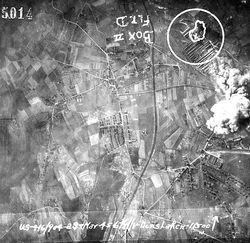 |
Lou Prucha WWII Service
|
 |
Dinslaken, Germany
(Built Up Area)

Pilot's Flight Log |

12th Army Group Situation Map 23-Mar-1945 |
in Box 1, Flight 3, Position 2.
Click to display the official 416th Bomb Group Mission Folder, Mission Report and Operational Report
scanned to PDF files by the Air Force Historical Research Agency (AFHRA).
Photo from the collection of Phil Stanley, see Wayne Sayles' 416th Bomb Group missions #250 page.
A 670th Bomb Squadron aircraft piloted by Lt. Ford along with his gunner S/Sgt. Tharp was lost on this mission (MACR 14314).
Group, Unit and Historical Extracts for Mission 250
"416th Bombardment Group (L) - Group History 1945"
Transcribed from USAF Archives
Our 250th mission, the 33rd of the month and our 50th in 43 days, took off in the afternoon of the 23rd. This time the town of Dinslaken was attacked. Smoke from our morning's bombing still hung over the target. Three boxes of eight flights dropped 64 tons of a new type of incendiary bomb which was supposed to be inextinguishable. The fires swept through the town. Counter-battery fire was very effective because weak, inaccurate flak was encountered. The three boxes were led by Major Ferris, Lts. Royalty and McNutt, B&N, Lt. Brewster, with Lt. Dennis and F/O F.J. Conley, B&N, and Capt. Tutt, with Lt. L.A. Orr, B-N.
"Attack Bombers, We Need You! A History of the 416th Bomb Group"
Ralph Conte
Pages 239 - 240
Mission #250 - 23 March - PM - Dinslaken Factory Area. Major Ferris, Lts. Royalty and McNutt, BNs led Box I. Lt. Brewster with Lt. Dennis and F/O Conley, BNs were on Box II. Captain Tutt and Lt. Orr BN leading Box III. Heavy smoke from the morning mission did not deter the bombs dropped in the PM from adding to the conflagrations, our boys dropping incendiaries. Most of the town was also on fire. Three boxes of eight planes each dropped 64 tons of a new type incendiary bomb, which was supposed to be inextinguishable. Weak inaccurate flak came up. Lts. Buskirk and Hanna BN led a flight with success.
"History of 670th Bombardment Squadron (L)"
Transcription from USAF Archives
Two missions were run on the 23rd against the Dinslaken Factory. In the morning superior results were achieved with 1000-pound bombs and again in the afternoon another superior was scored using 500-pound incendiary bombs. A total of 17 of our crews took part in these two missions.
"671st Bomb Squadron (L) Unit History"
Gordon Russell and Jim Kerns
For the third successive day the Ninth Bomb Division, including the 416th Group, delivered morning and afternoon blows at enemy defenses between Munster and the Rhine. Crews observed smoke and fire raging throughout the whole sector as the aerial onslaught went on. The A-69 Invaders hammered at the Dinslaken factory in the morning and went back to hit at roads and buildings in the town in the afternoon. Both missions were maximum effort, crews dropping thousand pound GPs in the morning and 500 pound incendiaries in the afternoon.
Excellent, superior and undetermined results were made against the factory. Lt. Lackovich and Lt. Muir were unable to get pictures due to evasive action, but visual reports state bombs hit on buildings. The new bombardiernavigator-pilot team of Captain Sutton and Lt. Reed annexed a superior on their first visual bombing mission as bursts blanketed large factory buildings. Five ships received battle damage and one crashed landed, but the crew reported safe. The factory was a large steel-rolling mill, which the Germans are reported using as an observation post to detect Allied positions and movements across the Rhine.
The incendiary bombing in the afternoon was recorded as excellent to superior although due to no photos available, undetermined results were given on paper. There was smoke and haze over the target and violent evasive action was taken, making the correct taking of pictures impossible. There were no losses, casualties or battle damage.
"USAAF Chronology of WWII, month by month"
TACTICAL OPERATIONS (Ninth Air Force): In Germany, around 800 A-20s, A-26s and B-26s strike 7 communications centers, a factory, and targets of opportunity (including several flak positions); attacks on communications centers are aimed at obstructing the movement of reinforcements to the front; fighters escort the bombers, fly patrols and armed reconnaissance, attack assigned ground targets, support the US III and VII Corps SE of Honnef and E of the Wied River and the XII and XX Corps astride and on the W bank of the Rhine River between Mainz and Worms. The 107th Tactical Reconnaissance Squadron, 67th Tactical Reconnaissance Group, moves from Gosselies, Belgium to Vogelsang, Germany with F-6s.
